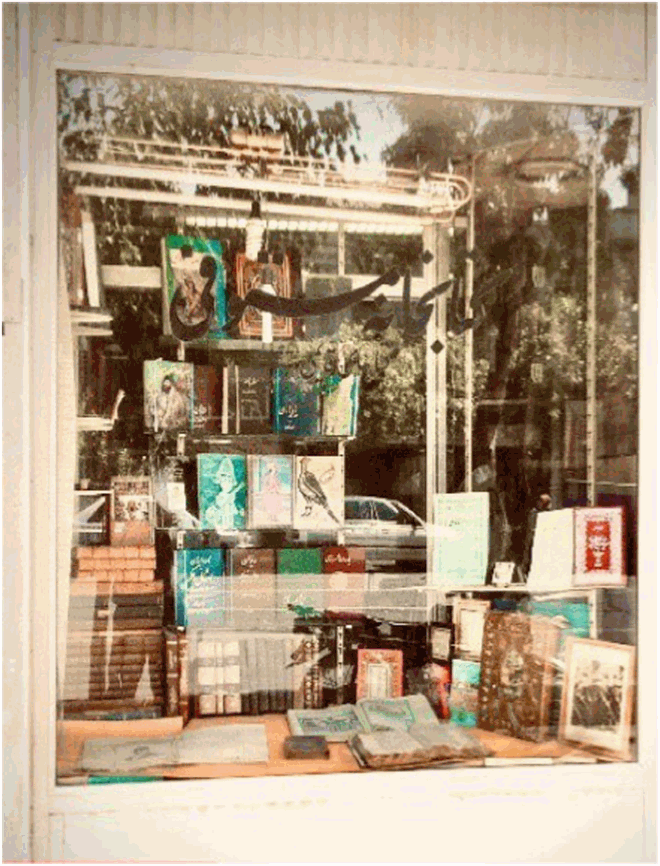
Khalil Mostowfi
Khalil Mostowfi was born in the old Khiābān neighborhood in Tabriz to a merchant family with a keen interest in books and trading relations in the Caucasus.Footnote 1 In 1948 he began his studies at Kamāl School in Tabriz, where he completed both his primary and secondary education. In these early years, and while still at school, he also worked as an apprentice at Sorush Bookstore, owned by a relative, Hājj Hossein Sorush Tabrizi.Footnote 2
Around 1963, Mostowfi and his family moved to Tehran, where he first worked at the Tehran branch of Sorush Bookstore and then, following the recommendation made on his behalf by Hājj Hossein Sorush, also worked at Adabiyeh Bookstore, owned by Hājj Vali Adabiyeh Tabrizi. This bookstore was located at Nāser Khosrow Street, which at the time was one of the main centers of the book trade in Tehran.Footnote 3 It was at Adabiyeh Bookstore that Mostowfi initially acquired firsthand knowledge of manuscripts and of the market for antiquarian books, in which he eventually became an expert. In 1966 he opened his own shop, Ketābkhāneh-ye Mostowfi, at 185 Shāhābād Avenue, between Saʿdi and Zahir al-Islam streets, near Parliament Square (Bahārestān) in central Tehran. Gradually the shop became a meeting place for collectors and the literati to discuss and to acquire or transact old books and manuscripts—which was perhaps an indication of the very close relationship that traditionally existed between booksellers and scholars. Literati used to frequent certain bookshops, sit and socialize, and in some cases even used them as their postal address.Footnote 4
In the 1960s Shāhābād Avenue, within walking distance of the old Dār al-Fonun college and Tehran University’s off-campus Faculty of Theology and Islamic Studies, was already established as a center for bookstores. Some of these bookstores had branched out from the older outlets in Tehran bazaar. For instance, in the same vicinity there were bookstores, such as Asadi (also near Bahārestān Square) and Ramazāni.Footnote 5 Within a short walking distance were the Ibn Sinā bookshop at Mokhber al-Dowleh Square and Ketābforushi-ye Dānesh in Saʿdi Street, founded in 1935 by Sayyed Nurollāh Irānparast (1910–92).Footnote 6 Other bookstores in the same vicinity who were also publishers, included Eqbāl, Safi-ʿAlishāh, and Amir-Kabir that was founded by ʿAbd al-Rahim Jaʿfari (1919–2015) and soon became a leading publishing house.Footnote 7
Mostowfi Bookstore was a small and modest shop with shelves on three walls from the floor to the ceiling that were filled with a selective range of classics in Iranian studies from history and genealogy to literature and geography; it also housed an oversized lithograph edition of popular titles that were mostly printed in the nineteenth century in India, Egypt, Lebanon, Iraq, and Turkey, as well as in Iran. There was a special section on the shelves within easy reach of his desk with a clearly visible notice “These Books Are Not for Sale”—these mostly consisted of early editions of catalogues of rare books that worked like a toolkit for him. This sign often perplexed casual customers, who would soon realize that this was not an ordinary bookshop. Soon after its inauguration the shop became a favorite haunt for small circles of the literati and Iranologists from home and abroad who would, over the next five decades, frequent the shop to inspect private collections that had come up for sale or discuss manuscripts and old books. His years of direct exposure to various library collections and firsthand experience with manuscripts and lithograph editions provided him with an opportunity to be closely associated with or consulted by many luminaries of his time, such as Jalāl al-Din Homāʾi (1900–80), Jalāl al-Din Mohaddes Ormavi (1904–79), Sayyed Mohammad Mohit-Tabātabāʾi (1901–92), Mojtabā Minovi (1903–77), Khān-Bābā Moshār (1900–80), Mohammad-Taqi Dānesh-Pazhuh (1911–96), ʿAli-Naqi Monzavi (1923–2010), Ahmad Monzavi (1925–2015), Iraj Afshār (1925–2011), Sayyed ʿAbdollāh Anwār (b. 1924), and Javād Safinejād (b. 1929). Among them Mostowfi was more regularly in contact and in company with Moshār (who lived near his bookstore), Dānesh-Pazhuh, and Afshār.Footnote 8 His most regular and enduring association, however, was with ʿAbd al-Hossein Hāʾeri (1927–2015), who was arguably the doyen of Iran’s librarians and a longtime head of the Majles (Parliament) Library. Mostowfi collaborated with Hāʾeri for close to forty years at the Majles Library—he was a member of the Majles Library committee for the authentication, appraisal, and acquisition of manuscripts and rare titles.Footnote 9 He was also a member of the Council for the Registration of National Heritage at Iran’s Ministry of Cultural Heritage.

Mostowfi Bookstore, 185 Shāhābād Avenue, Tehran
Mostowfi’s expertise combined with a professional manner usually devoid of superfluous interjection of peripheral topics of conversation, combined with his signature verbal economy and focused gaze, inspired confidence within both private clients and institutional circles.Footnote 10 Mostowfi also regularly and routinely dealt with domestic collections. Once his reputation was established as an expert and honest assessor with access to potential buyers, private collectors turned to him to appraise or sell their material. In good measure such a market resulted from a certain set of social variables, such as the inevitable generational change in book collector families, downsizing residential settings, and inheritance matters. Such private collections often consisted of property deeds, privately arranged documentation (such as promissory notes and affidavits), business accounting books and ledgers, or nineteenth-century lithograph editions of popular titles such as prayer books, various lithograph editions of the Shāhnāmeh and Romuz-e Hamzeh, or literary classics such as volumes by Rumi, Saʿdi, and Hāfez, and bound issues of old periodicals such as Sharaf (1882–91) and Sherāfat (1896–1904) published in Tehran or bound issues of Habl al-Matin that was initially published as a weekly in Calcutta (1893–c. 1930) and later also as a daily newspaper in Tehran (1907–9) and in Rasht as well.Footnote 11 At a relatively smaller scale there were manuscripts of the Qurʾān or the literary Persian classics with tangible market value; here Mostowfi’s expertise was often solicited.
His passion for manuscripts and rare books motivated him to travel to various places around the country to secure new acquisitions. For the same purpose he also regularly traveled abroad, mostly to India. For instance, during 1971–78, he frequently traveled to India (twenty times by his own estimation) in order to acquire Persian manuscripts, lithographs, and rare books.Footnote 12 In addition to his acquisition of and trade in rare titles and assessment of manuscripts, from time to time Mostowfi also worked as a publisher—for instance, during the period 1980–2000 Ketābkhāneh-ye Mostowfi published some twenty titles.Footnote 13
Over the years Mostowfi closely collaborated with a number of major Iranian research libraries such as Tehran University’s Central Library and Documentation Center; National Library of Iran; Majles Library, Museum, and Documentation Center (which, in addition to its own collection, also housed the stacks of the former Senate Library); Rezā ʿAbbāsi Museum in Tehran; and the Malek Library, also in Tehran. In 2008 he donated some seventy-three volumes of rare books and manuscripts to the National Library of Iran. This was followed by another donation, in 2018, of some 500 manuscripts and rare titles to the Āstān-e Qods-e Razavi Library at Mashhad.
During his lifetime Mostowfi was widely recognized for his expertise in and contributions to the preservation of manuscripts and rare books relating to Iranian studies. He was acclaimed as “Distinguished Expert” by the National Library of Iran at its inaugural Ceremony in Recognition of the Preservers of Manuscripts (2000); as “Distinguished Bookseller” by the Ministry of Culture at the Annual Book Week (2009); and, shortly before his passing, as an outstanding “Book Donor,” by the Āstān-e Qods-e Razavi Library at their Fourth Ceremony in Recognition of Book Donors (January 2020).Footnote 14
Khalil Mostowfi passed away on Thursday 20 February 2020 and is buried at the Behesht-e Zahrā Cemetery south of Tehran.


